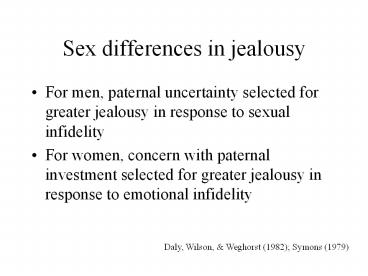Sex differences in jealousy PowerPoint PPT Presentation
1 / 29
Title: Sex differences in jealousy
1
Sex differences in jealousy
- For men, paternal uncertainty selected for
greater jealousy in response to sexual infidelity - For women, concern with paternal investment
selected for greater jealousy in response to
emotional infidelity
Daly, Wilson, Weghorst (1982) Symons (1979)
2
(No Transcript)
3
(No Transcript)
4
Who cares?
Grrr
5
Grrr
6
(No Transcript)
7
Selection for sexual jealousy in men
8
Forced-choice
Please think of a serious committed romantic
relationship that you have had in the past, that
you currently have, or that you would like to
have. Imagine that you discover that the person
with whom youve been seriously involved became
interested in someone else. What would distress
or upset you more (please circle only one) (A)
Imagining your partner forming a deep emotional
attachment to that person.(B) Imagining your
partner enjoying passionate sexual intercourse
with that other person.
Buss, Larsen, Westen, Semmelroth (1992)
9
Buss et al. (1992) results
10
Physiological evidence
- Women and men imagined a sexual infidelity and an
emotional infidelity - Electrodermal activity, pulse rate, and
electromyographic activity were measured - Men more reactive to sexual infidelity imagery
than emotional infidelity imagery - Women slightly more reactive to emotional
infidelity imagery than sexual infidelity imagery
Buss, Larsen, Westen, Semmelroth (1992)
11
Criticisms
- Results dont replicate when jealousy is assessed
using continuous measures - Reactions to hypothetical infidelity scenarios
might not align with reactions to actual
infidelity experiences
Harris (2002, 2003, 2005) Sagarin (2005)
12
How jealous would you feel about your partner
forming a deep emotional attachment to that
person?
1Not at all jealous 2 3 4 5 6 7Extremely jealous
13
Response
- Same pattern emerges (sometimes) when continuous
measures are used - Retrospective reports of actual infidelity
experiences align with reactions to hypothetical
infidelity scenarios
Sagarin, Becker, Guadagno, Nicastle, Millevoi
(2003)Edlund, Heider, Scherer, Farc, Sagarin
(2006)
14
Criticism
- Physiological measures are ambiguous. Do they
represent jealousy or something else?
Harris (2000)
15
Response
- Harris criticism of the physiological data has
not been addressed
16
Measurement
- Dictionary definition The act or process of
measuring - Psychology and statistics textbooks
- My definition The attempt to accurately assess
a construct of interest
17
Construct An abstract concept
18
Construct validityThe extent to which a
concrete manifestation of an abstract concept
(construct) is an accurate or true reflection of
the underlying construct(Aronson, Ellsworth,
Carlsmith, Gonzales, 1990, p. 346)
19
Operational definitionThe definition of a
concept construct by means of specifying the
operations required to manipulate or measure the
concept.
20
Types of Dependent Variables
- Verbal measures
21
Questionnaires
22
The Likert Scale
1)
Strongly Agree Neutral Disagree Stronglyagree
disagree
2)
Strongly Agree Neutral Disagree Stronglyagree
disagree
23
How much do you agree with the following
statement?I am in good health
Strongly disagree Disagree Some-what disagree Neither agree nor disagree Some-what agree Agree Strongly agree
24
How is your health?
Very poor Poor Some-what poor Fair Good Very good Excellent
25
The Semantic Differential
Good ____ ____ ____ ____ ____ ____ ____ Bad
Kind ____ ____ ____ ____ ____ ____ ____ Cruel
Sour ____ ____ ____ ____ ____ ____ ____ Sweet
26
Interviews
- Participants may pay better attention
- Participants may be motivated to respond
carefully - Experimenter can clarify questions
- Experimenter can ask open-ended questions
- Problems?
27
Types of Dependent Variables
- Verbal measures
- Behavioral measures
- Behavioroid measures
- Physiological measures
- Indirect measures
28
Types of Dependent Variables
- Behavioral measures Measures of subjects
concrete, actual behaviors in the experimental
setting (e.g., level of shock administered to a
confederate length of time subjects work to
solve a puzzle number of times drivers honk
their horns) - Behavioroid measures Measures that require
subjects to commit to a future behavior without
actually having to perform it later (e.g., number
of hours subjects agree to tutor a needy student
number of questionnaires subjects commit to help
a confederate score)Definitions from Aronson,
Ellsworth, Carlsmith, and Gonzales (1990)
29
Types of Dependent Variables
- Physiological measures Measures of such bodily
processes as blood pressure, heart rate, and
pupil dilation that are usually beyond the
conscious control of subjects - Indirect measures Measures for which the
connection between the score itself and some
other variable of interest involves some kind of
hypothetical intervening process (e.g., recall
errors as an indirect measure of attitudes
reaction time as an indirect measure of depth of
information processing)Definitions from
Aronson, Ellsworth, Carlsmith, and Gonzales (1990)

